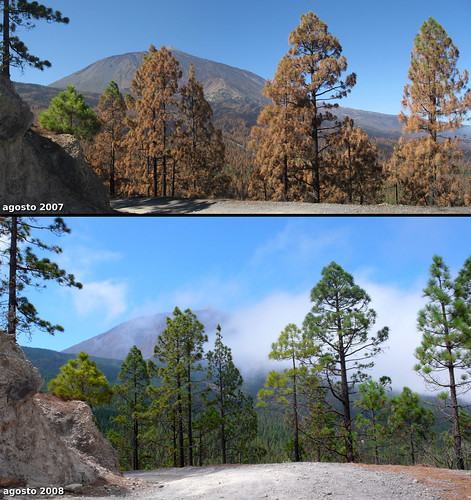 |
| Map of Tenerife prior to the Spanish conquest |
Many of
Tenerife's place names (
such as those shown on this map) date back to the time of the
Guanches, before the Spanish conquest. Names like
Adeje,
Güímar,
Tacoronte (a
toponym of
Guanche origin, believed to be derived from "
Tagoror," meaning "place where the Council of Elders meets") and
Tegueste are still used for town names today. Others, like
Taoro or
Daute, are still in use, however, the literal meanings of these are not always apparent.
Guanche language being extinct, there aren't that many Spanish-Guanche dictionaries, much less any meaningful
Guanche-English vocabulary.
We know that
Tenerife bears the name that was used for the island by the inhabitants of the neighbouring island of
La Palma; “Tene” signifying “mountain” and “ife” meaning white (the “r” was added by the Spanish). The natives of Tenerife itself called the island
Chenech, Chinech or Achinech."
There's still much debate over the naming of the
islas canarias (Canary Islands) themselves, but, it occurred to me when I spotted an item pointing to an Atlas of True Names that there's much more fun to be had translating the literal meanings of some of the Spanish place names on the island:
Starting with
The Christians (
Los Cristianos), which is probably most familiar with visitors, so named because, missionaries had visited the area and converted the locals, before the rest of the island.
The Giants (
Los Gigantes),
as we've said before, get's its name from the giant 300-600 metres cliffs after which the town has been named.
 |
| Roque de Garachico |
Tradition says
Garachico is part Guanche from "igara" meaning island and part Spanish, "
chico" meaning small, thus
Small Island, referring to the
Roque de Garachico, the
rocky outcrop just offshore.
Many place names start with
Saint "
San", usually referring to the one chosen, for some (often obscure) reason or another, to look after the area. Find out when that saint's day is and you'll also have a clue as to when there might be fiestas to attend.
Some names sound positively exotic or hopelessly romantic in Spanish, where their literal meanings in English sound rather banal or positively
trite.
Playa De La Arena means "Beach of the sand" or
Sandy Beach. A bit obvious but at least it does have sand, albeit black, unlike the
Las Arenas (
The Sands) beach at Buenavista del Norte, which consists almost exclusively of rocks!
Buenavista de Norte itself sounds so pretty in Spanish, whereas the English equivalent "good view of the north" - 'coz it had a nice, fertile, look about it to the incoming colonizers - just doesn't evoke the same feeling somehow.
The Silos (
Los Silos)' uninspired name first appears in 1509, when agricultural activity required the construction of grain silos to store cereals there.
While,
The Tank (
El Tanque) takes its name from the irrigation tank or reservoir, the remains of which
can still be found in Tanque Bajo.
Several places were named in direct reference to the events of the Spanish conquest.
The Royalists (
Los Realejos), recalls the faction camped in the low area of the town during those events.
The Victory (
La Victoria) refers to the one won by the Spanish there in 1494, while
The Slaughter (
La Matanza) refers to the terrible defeat the Spanish suffered in the first battle. (Like most history, of course, it was written and the names were given, by the eventual winners!)
Holy Cross (
Santa Cruz) is so named, because that is where
conquistador,
Alonso Fernández de Lugo planted a cross (the very one is still kept in the church,
Iglesia de La Concepción) in the name of the
Catholic Monarchs.
Port of the Cross (
Puerto de la Cruz) was formerly known as "Crossport" and the main square there is the
Plaza del Charco, a very picturesque sounding name that translated literally, becomes the rather dull,
Puddle Place.
Less obvious - though potentially even more entertaining to the puzzled, casual onlooker - are the reasons (which we cannot explain) for naming
The Silent Coast (
Costa del Silencio), when it has the noisy airport so close.
... nor
The Biscuits (
Las Galletas) or
The Overcoats (
Los Abrigos).
Armed with these examples and a little mischievous curiosity, you can now go forth around Tenerife's towns and villages, streets and plazas and wonder how they came to be called what they are and, what they mean literally.
A few more literal place names:
The Lagoon (
La Laguna),
Candlemas (
Candelaria),
Passion Fruit (
Granadilla),
Willow Tree (
El Sauzal),
The Rosary (
El Rosario),
The Sand Dune (
El Médano),
Village of Flowers (
Vilaflor).






 After more than 20 years, posts here will now only be occasional (
After more than 20 years, posts here will now only be occasional (





